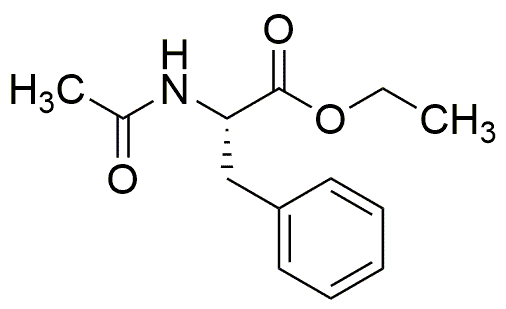Acetyl-L-phenylalanine ethyl ester is widely utilized in research focused on:
- Pharmaceutical Development: This compound serves as a building block in the synthesis of various pharmaceuticals, particularly in the development of peptide-based drugs that target specific biological pathways.
- Neuroscience Research: It is used in studies investigating neurotransmitter functions and neuroprotective effects, helping researchers understand conditions like Alzheimer's and Parkinson's disease.
- Biotechnology: In the field of biotechnology, it aids in the production of modified proteins and enzymes, enhancing their stability and activity for industrial applications.
- Cosmetic Formulations: The compound is incorporated into skincare products for its potential anti-aging properties, providing benefits such as improved skin hydration and elasticity.
- Food Industry: It is explored as a flavoring agent or additive, contributing to the enhancement of taste profiles in various food products.
General Information
Properties
Safety and Regulations
Applications
Acetyl-L-phenylalanine ethyl ester is widely utilized in research focused on:
- Pharmaceutical Development: This compound serves as a building block in the synthesis of various pharmaceuticals, particularly in the development of peptide-based drugs that target specific biological pathways.
- Neuroscience Research: It is used in studies investigating neurotransmitter functions and neuroprotective effects, helping researchers understand conditions like Alzheimer's and Parkinson's disease.
- Biotechnology: In the field of biotechnology, it aids in the production of modified proteins and enzymes, enhancing their stability and activity for industrial applications.
- Cosmetic Formulations: The compound is incorporated into skincare products for its potential anti-aging properties, providing benefits such as improved skin hydration and elasticity.
- Food Industry: It is explored as a flavoring agent or additive, contributing to the enhancement of taste profiles in various food products.
Documents
Safety Data Sheets (SDS)
The SDS provides comprehensive safety information on handling, storage, and disposal of the product.
Product Specification (PS)
The PS provides a comprehensive breakdown of the product’s properties, including chemical composition, physical state, purity, and storage requirements. It also details acceptable quality ranges and the product's intended applications.
Certificates of Analysis (COA)
Search for Certificates of Analysis (COA) by entering the products Lot Number. Lot and Batch Numbers can be found on a product’s label following the words ‘Lot’ or ‘Batch’.
*Catalog Number
*Lot Number
Certificates Of Origin (COO)
This COO confirms the country where the product was manufactured, and also details the materials and components used in it and whether it is derived from natural, synthetic, or other specific sources. This certificate may be required for customs, trade, and regulatory compliance.
*Catalog Number
*Lot Number
Safety Data Sheets (SDS)
The SDS provides comprehensive safety information on handling, storage, and disposal of the product.
DownloadProduct Specification (PS)
The PS provides a comprehensive breakdown of the product’s properties, including chemical composition, physical state, purity, and storage requirements. It also details acceptable quality ranges and the product's intended applications.
DownloadCertificates of Analysis (COA)
Search for Certificates of Analysis (COA) by entering the products Lot Number. Lot and Batch Numbers can be found on a product’s label following the words ‘Lot’ or ‘Batch’.
*Catalog Number
*Lot Number
Certificates Of Origin (COO)
This COO confirms the country where the product was manufactured, and also details the materials and components used in it and whether it is derived from natural, synthetic, or other specific sources. This certificate may be required for customs, trade, and regulatory compliance.


